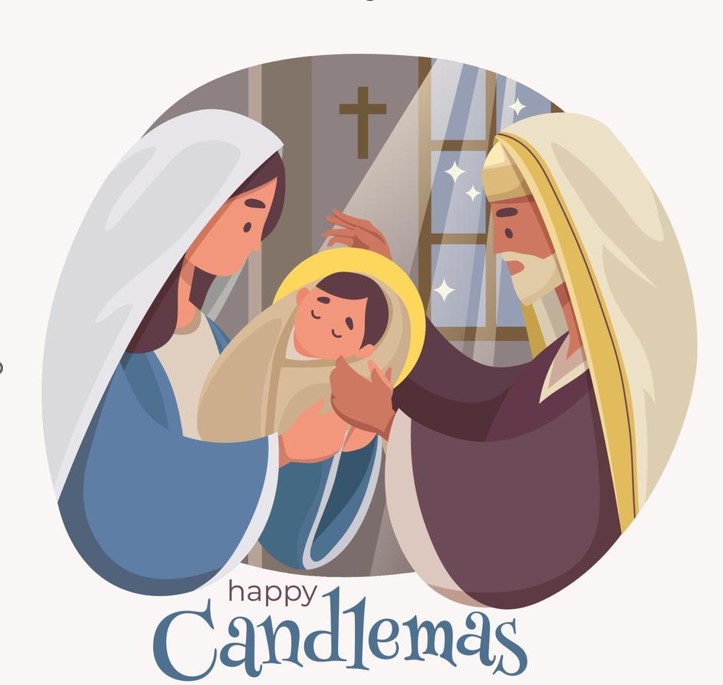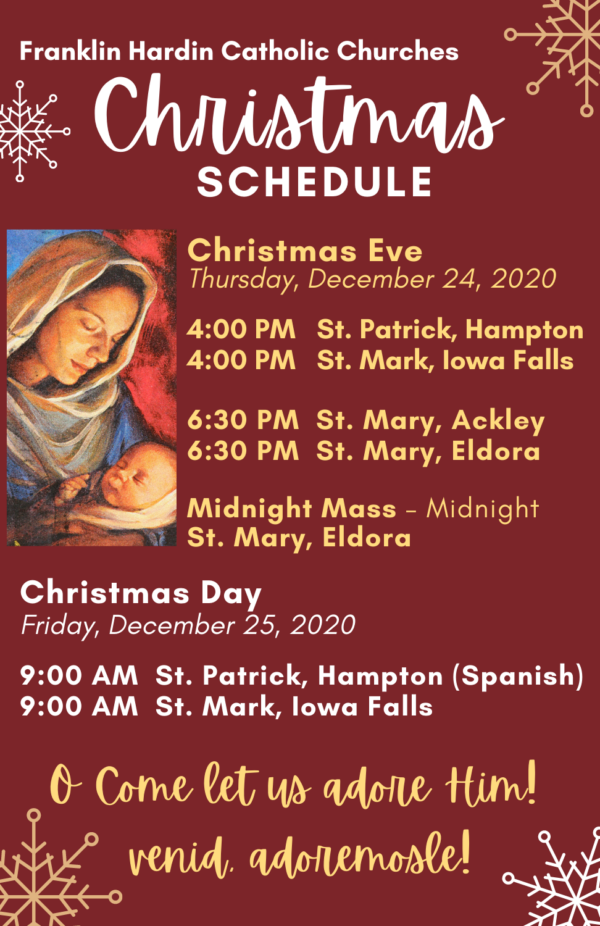Next Sunday, Feb. 2 is the Feast of the Presentation, that is when we commemorate the event of the child Jesus being brought to the Temple forty days after his birth, according to Old Testament Biblical Law. As it says in Luke 2: “When the days were completed for their purification, according to the law of Moses, Mary and Joseph took Jesus up to Jerusalem to present him to the Lord, just as it is written in the law of the Lord, Every male that opens the womb shall be consecrated to the Lord, and to offer the sacrifice of a pair of turtledoves or two young pigeons, in accordance with the dictate in the law of the Lord.” Why do we celebrate this on Feb. 2? Because Feb. 2 is 40 days AFTER Christmas (Dec. 25) when we celebrate the BIRTH of Jesus.
There is also a tradition on this feast day of blessing candles; hence, why historically this feast is also referred to as Candlemas. The blessing of candles become attributed to this day, because when the infant Jesus was brought to the Temple, Simeon proclaimed recognized Jesus as the light of the world and proclaimed, “… my eyes have seen your salvation, which you prepared in sight of all the peoples, a light for revelation to the Gentiles (peoples/nations).”
Some cultures also traditionally used this feast day to predict the length of winter, that if “Candlemas is fair and bright, winter will have another flight” – winter will still be long. But if “Candlemas brings cloud and rain, winter will go and not come again” – winter will end soon and spring will come early. And of course, some of those cultures started to use an animal for these predictions, and thus, the American Groundhog’s Day was born, thanks to this Catholic Feast Day!
Finally, I want to share with you this poem by St. John Henry Newman that he wrote about “Candlemas” as transitioning us from the final remnants of the Christmas Season and turn our hearts to prepare for Lent, Holy Week, and eventually Easter. We turn from the light of Christmas towards the light of Easter.
“Candlemas” – St. John Henry Newman (The Oratory, 1849)
“The Angel-lights of Christmas morn, Which shot across the sky,
Away they pass at Candlemas, They sparkle and they die.
Comfort of earth is brief at best, Although it be divine;
Like funeral lights for Christmas gone, Old Simeon’s tapers shine.
And then for eight long weeks and more, We wait in twilight grey,
Till the high candle sheds a beam, On Holy Saturday.
We wait along the penance-tide, Of solemn fast and prayer;
While song is hush’d, and lights grow dim, In the sin-laden air.
And while the sword in Mary’s soul, Is driven home, we hide
In our own hearts, and count the wounds, Of passion and of pride.
And still, though Candlemas be spent, And Alleluias o’er,
Mary is music in our need, And Jesus light in store.”
Peace,
– Fr. Kevin
26 de enero – Fiesta de la Presentación del Señor, “Candelarias”
El Domingo que viene, el 2 de febrero es la Fiesta de la Presentación del Señor, que conmemora el evento cuando se lleva al niño Jesús al Templo cuarenta días después de haber nacido, según la Ley Bíblica del Antiguo Testamento. Como dice en Lucas 2: “Y cuando se cumplieron los días de la purificación de ellos, conforme a la ley de Moisés, le trajeron a Jerusalén para presentarle al Señor (como está escrito en la ley del Señor: Todo varón que abre la matriz será llamado santo al Señor), y para ofrecer conforme a lo que se dice en la ley del Señor: Un par de tórtolas, o dos palominos”. ¿Por qué celebramos esto el 2 de feb? Ya que en esta fecha son 40 días DESPUÉS de Navidad (25 de dic.) cuando celebramos el NACIMIENTO de Jesús.
También, durante esta fiesta, se celebra la tradición de la bendición de velas; razón por la cual, a esta fiesta también se le llama Candelaria. Se atribuye a este día la bendición de las velas, porque cuando el niño Jesús fue llevado al Templo, Simeón proclamó reconocer a Jesús como la luz del mundo y proclamó, … “Porque han visto mis ojos tu salvación, que has preparado a la vista de todos los pueblos: luz que ilumina a las naciones y gloria de tu pueblo Israel”.
Algunas culturas también usaban tradicionalmente esta fiesta para predecir la duración del invierno, “Si la Candelaria llora ya está el invierno fuera; pero si echa a reír, el invierno esta por venir”. Y por supuesto, algunas de esas culturas comenzaron a usar un animal para estas predicciones y, por lo tanto, nació así el Día de la Marmota, ¡gracias a esta Fiesta Católica!
Finalmente, quiero compartir con ustedes este poema de San Juan Enrique Newman quien escribió sobre las “Candelarias” como una transición de los restos finales de la temporada navideña para volcar nuestros corazones a prepararnos para la Cuaresma, la Semana Santa y, finalmente, la Pascua. Pasamos de la luz de Navidad a la luz de Pascua.
“Candelaria” – San Juan Enrique Newman (El Oratorio, 1849)
Las luces que cruzaron el cielo, la mañana de Navidad,
en Candelaria están ya lejos,centellearon y murieron.
En la tierra, el consuelo, aun el divino, es, a lo más, breve. Como lámparas
de duelo por la Navidad ya ida, brillan las candelas del anciano Simeón.
Y así por largas ocho semanas, y más, aguardamos en un crepúsculo gris,
hasta que el rayo del cirio resplandece, el Sábado Santo.
Esperamos en la estación de penitencia, en ayuno solemne y en plegaria.
Se acallan los cantos y se atenúan las luces, en el aire denso de pecado.
Mientras la espada encuentra su camino, en el alma de María,
escondidos en nuestro corazón vamos contando, las heridas de la pasión y del orgullo.
Y pese a todo, aunque haya concluido, la Candelaria, y calla el Aleluya,
María es música para nuestra pena, y la luz de Jesús está ya pronta.
Paz,
– Padre Kevin
| ReplyReply allForward |


